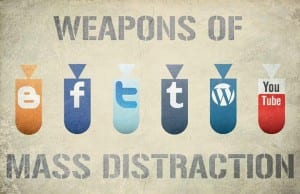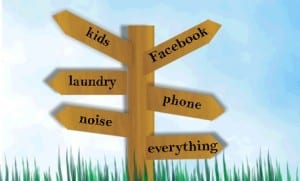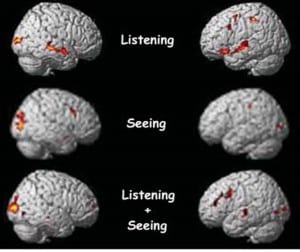 The foundation for developing situational awareness is perception – using your senses to gather information about what is happening around you. In lay terms, we call it paying attention. It would be difficult, if not impossible, to develop strong situational awareness if you are not paying attention to what is happening around you.
The foundation for developing situational awareness is perception – using your senses to gather information about what is happening around you. In lay terms, we call it paying attention. It would be difficult, if not impossible, to develop strong situational awareness if you are not paying attention to what is happening around you.
For better or worse, we are living in a world where the need to pay attention, as a matter of personal safety, has become paramount. However, distractions can pull your attention in many different directions and can cause significant issues in forming and maintaining your situational awareness.
Sources of distractions
 It’s not difficult to make a list of sources of distraction that can impact awareness: Smartphones, electronic readers and notebooks, headphones, GPS devices, electronic billboards, vehicle wraps (advertising), wall-to-wall televisions (in some venues) and crowds just to name a few.
It’s not difficult to make a list of sources of distraction that can impact awareness: Smartphones, electronic readers and notebooks, headphones, GPS devices, electronic billboards, vehicle wraps (advertising), wall-to-wall televisions (in some venues) and crowds just to name a few.
But there are also some internal sources of distraction – the thoughts that occupy our minds and draw our attention away from potential signs of danger. Some of these might include worry, frustration, anger, fear, to-do lists, conversations, and noise.
Paying attention
Brain scans using fMRI technology has allowed neuro researchers to better understand what is happening in the brain as we give our attention to a task, as we multitask and as we shift attention between tasks. The results of the numerous studies have all confirmed an astounding fact.
It is biologically impossible for the human brain to multitask the act of paying attention. Now, this requires a little explaining because there are readers who will refute this by saying driving a car while carrying on a conversation requires multitasking. Or playing a trumpet while marching in formation requires multitasking.
 And you would be right. And science would support your argument. But you’re still not simultaneously giving your conscious attention to more than one task at a time. Rather, what happens is when you have more than one thing to pay attention to (at the conscious level of awareness), your brain shifts attention between the multiple tasks. It alternates attention from one task to the other and then, perhaps, back to the first task or onward to a third task.
And you would be right. And science would support your argument. But you’re still not simultaneously giving your conscious attention to more than one task at a time. Rather, what happens is when you have more than one thing to pay attention to (at the conscious level of awareness), your brain shifts attention between the multiple tasks. It alternates attention from one task to the other and then, perhaps, back to the first task or onward to a third task.
Here’s an example of what I mean. Stretch your arm out in front of you and hold your thumb up. Now, look at your thumbnail. It should be in clear focus. Now, look beyond your thumbnail and focus your attention on an object beyond your thumb (say, for example, ten feet past your outstretched arm). The object you are looking at should be in clear view. And your thumbnail should now be blurry. Now, refocus your attention on to your thumbnail and it should once again come into clear focus. At the same time, the object beyond your thumb that you were focused on will become blurry.
Now, focus your attention on both your thumbnail and the object behold your hand and make them both come into clear focus simultaneously. You will quickly see that, unless you have some special gifts, it will be an impossible task. It is not possible for the eyes to focus on both at the same time and it is impossible to give your conscious attention to two things at the same time.
Subconscious attention
So far the discussion has been on conscious attention. There is, however, a second type of information processing occurring at the same time that conscious attention is happening. Your subconscious can capture and process multiple inputs, make sense out of them and use those inputs to drive decisions and actions.
 This is how someone can drive a car while carrying on a conversation or how a musician can play a trumpet while marching in formation. The subconscious brain is capturing and processing environmental information outside of your awareness, thus, the term subconscious attention.
This is how someone can drive a car while carrying on a conversation or how a musician can play a trumpet while marching in formation. The subconscious brain is capturing and processing environmental information outside of your awareness, thus, the term subconscious attention.
The more skilled you are at performing tasks, the better your subconscious brain can capture information, process it and drive decisions and actions. A skilled musician doesn’t have to really “pay attention” to their hand position on the instrument to play the music. It’s automatic processing – subconscious. The same with the skilled driver who carries on a conversation during a long drive only to realize that parts of the trip cannot be remembered at all. That’s because the driver was using subconscious processing.
What’s on your TV screen?
 Conscious information processing occurs in your head as programs play on a television screen. You can only watch one channel at a time. As you change channels, you are at risk of missing something on the other channel. As you shift attention, you are at risk of missing something else happening around you. You can flip back and forth between the channels very quickly, but alas you will miss something and it will inevitably cause confusion. The same will occur as you shift attention because things are distracting you off task.
Conscious information processing occurs in your head as programs play on a television screen. You can only watch one channel at a time. As you change channels, you are at risk of missing something on the other channel. As you shift attention, you are at risk of missing something else happening around you. You can flip back and forth between the channels very quickly, but alas you will miss something and it will inevitably cause confusion. The same will occur as you shift attention because things are distracting you off task.
Dr. Gasaway’s Advice
 It would be poor advice for me to tell you to never multitask (especially with the kind of work we do). It would be impossible. Just know that as you multitask, you are vulnerable to forgetting.
It would be poor advice for me to tell you to never multitask (especially with the kind of work we do). It would be impossible. Just know that as you multitask, you are vulnerable to forgetting.
It might also be poor advice to tell you not to let things distract you off task because we work in stimuli-rich environments where there are so many sights and sounds that can distract us. Simply know that when distracted, your conscious attention shifts to the distraction and you are no longer paying attention to something that could be vitally important.
Action Items
 1. Discuss a time when you were distracted and, as a result, missed important information.
1. Discuss a time when you were distracted and, as a result, missed important information.
2. Discuss strategies you have used that help you control distractions.
3. Discuss ways to maintain focus while operating in stimuli-rich environments (lots of sights and sounds).
_____________________________________________________

If you are interested in taking your understanding of situational awareness and high-risk decision making to a higher level, check out the Situational Awareness Matters Online Academy.
CLICK HERE for details, enrollment options and pricing.
__________________________________
Share your comments on this article in the “Leave a Reply” box below. If you want to send me incident pictures, videos or have an idea you’d like me to research and write about, contact me. I really enjoy getting feedback and supportive messages from fellow first responders. It gives me the energy to work harder for you.
Thanks,

Email: Support@RichGasaway.com
Phone: 612-548-4424
SAMatters Online Academy
Facebook Fan Page: www.facebook.com/SAMatters
Twitter: @SAMatters
LinkedIn: Rich Gasaway
Instagram: sa_matters
YouTube: SAMattersTV
iTunes: SAMatters Radio
iHeart Radio: SAMatters Radio

Pingback: Top 10 Ways To Handle Remote Work Effectively - SparkInList – A Collection Of Informative Articles